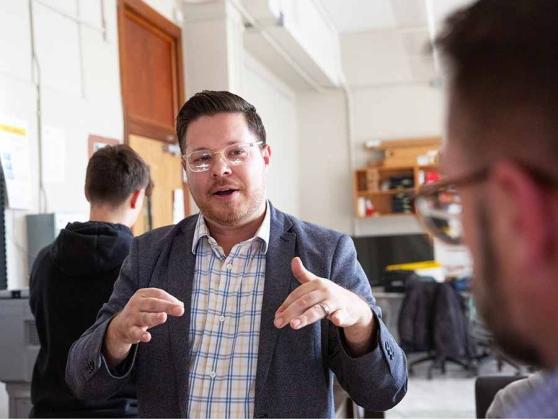
Isai Serrano teaches soft skills in his business simulation classes at McKee HS on Staten Island.
Communication. Teamwork. Adaptability. Problem-solving. Emotional intelligence. Whether you call them social-emotional, interpersonal or soft skills, the abilities that our students acquire through peer interaction are in decline.
Many experts have noted this drop in recent years due to the rise of technology and social media, but the after-effects of the isolation that students experienced during the COVID-19 pandemic have exacerbated the problem.
In a national survey of educators administered by the EdWeek Research Center in January 2022, 80% of respondents said the social skills and emotional maturity of their current students were much or somewhat less advanced compared to their students prior to the pandemic.
In the years ahead, the most valuable work skills will be ones that can’t be automated by machines or computers — such as soft skills — according to a recent Pew Research Center survey of about 1,400 technology and education professionals. Unlike learning a new software or work protocol, someone who has soft skills brings them from setting to setting, which makes them a more valuable candidate no matter what job they seek.
“These are the skills that every employer is looking for,” said Isai Serrano, a teacher-facilitator at Ralph McKee Career and Technical Education HS. He leads the school’s BUILD and Virtual Enterprise programs, which are business simulation classes that teach entrepreneurial skills to students. “Anyone can learn and have specific skill sets in certain areas,” he said, “but if you can’t communicate it, if you don’t know how to collaborate, if you buckle under pressure, it will be a detriment to the whole business.”
Nicole Brisotti, a UFT Teacher Center site coach, says learning soft skills shapes students’ overall development. “It empowers them to navigate challenges,” she said. “Whatever they face, they’ll be better prepared.”
So these skills are crucial and in-demand and helping students acquire them is much needed, but where to begin? Teachers are content-area experts, so addressing an intangible skill set with no set curriculum may seem daunting.
Suzanne Lemberg, the education program manager at MindUP, a social-emotional learning program conceived by the Goldie Hawn Foundation, says creating safe spaces within the school community lays the groundwork for building soft skills, because feeling physically and emotionally safe is a prerequisite for creating connections and relationships.
“When someone feels like they can be themselves and be vulnerable, that’s when learning compassion, empathy and patience can really take place,” she said.
With the union’s support, MindUP’s program is now integrated in 120 pre-K to grade 8 schools throughout the city. To build safe spaces, MindUP advises classes to establish community agreements that the students create in collaboration with their teachers that are more than just abiding by the rules of the classroom.
Agreements should be fluid and ever-evolving, Lemberg said, with teachers and students “continuously having a conversation: Are we living up to our agreements or do we need to change an agreement?”
Lemberg said attentive listening is one interpersonal skill that deserves focus. “Listening is such an important skill that is actually so hard to do,” she said. “We say all the time, ‘You need to listen,’ but how do we really teach that skill?”
Lemberg suggested one fun way to teach listening would be to ask students to make note of things they overhear in the school hallways. “When you can really listen and pick up on what someone’s trying to share, it can take you far,” she said.
At Brisotti’s school, JHS 185 in Queens, they have embraced and fostered a schoolwide focus on social-emotional skills in partnership with MindUP. Brisotti encourages teachers to build strong relationships with students and help them draw connections between their own lives and what they’re learning in the classroom. “If you’re reading a story, have students answer, ‘How does this relate to your life?’ ” she advised.
Teachers at JHS 185 embed social-emotional learning into the regular curriculum. “We stop and talk about gratitude and kindness, or ask how a character could show empathy in a particular situation,” Brisotti said.
Serrano’s entrepreneurship classes primarily teach soft skills, but teachers of traditional subjects can borrow from the same playbook by incorporating strategies he uses, such as hands-on learning. Experiential learning teaches students an array of soft skills as they build content knowledge.
“I think there’s so much value in students learning by doing,” said Serrano. “I can teach you the theory, but I will then let you explore this idea and do it and manage it. Now the ball’s in your court. You’re deciding the path and then learning from those decisions.”
Brisotti said her school’s focus on social-emotional learning has led to “increased student interactions, more empathy among the students and a lot more rich conversations.”
JHS 185 students are also learning communication skills that will serve them long after middle school. “Students are able to give and receive feedback not only from their teacher, but from their peers in a more appropriate, positive way,” she said.
The term “soft skills,” in fact, may not be the best term to describe these competencies because it belies their importance. “I hate to even call them soft skills,” said Serrano, “because they’re really life skills.”